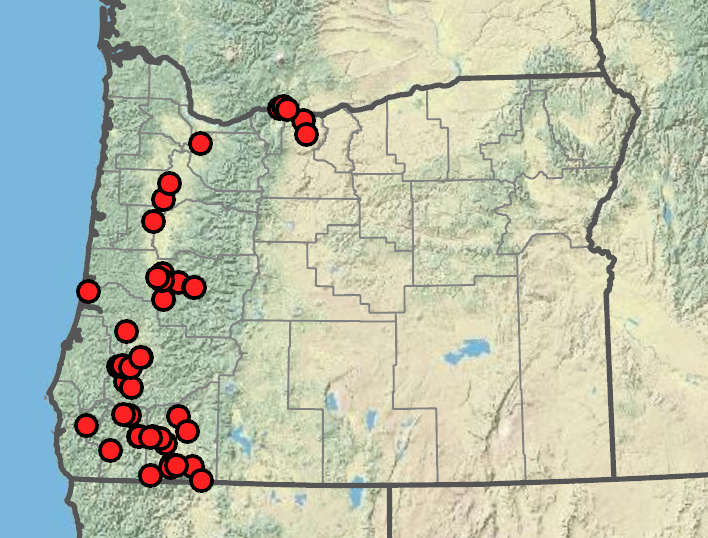Trifolium ciliolatum
Trifolium repens
foothill clover
Dutch clover, white clover
palmate;
leaflets 3, elliptic to oblong or obovate, 8–35 × 5–15 mm, bases cuneate;
margins serrate proximally, obscurely denticulate distally;
veins thickened;
tips usually rounded or retuse, rarely acute;
surfaces glabrous;
petioles 10–130 mm;
petiolules ~0.5 mm;
stipules ovate-lanceolate, 10–15 mm;
margins entire, sometimes ciliate;
tips acuminate.
pinnate;
leaflets 3, obovate, obcordate, or orbiculate, 6–40 × 4–25 mm, often with light markings, bases cuneate;
margins serrulate distally;
veins moderately prominent;
tips rounded, emarginate, or retuse;
surfaces glabrous;
petioles 50–200 mm;
petiolules ? 1 mm;
stipules lanceolate, 9–13 mm;
margins entire;
tips short-subulate.
axillary or terminal, 10–30-flowered; ovoid becoming subglobose, 7–22 × 5–20 mm;
involucres a narrow, membranous, dentate rim; ~0.5 mm;
bracteoles linear or cup-shaped; ? 1 mm.
axillary, 20–40+-flowered, globose, 15–35 × 15–35 mm;
involucres absent;
bracteoles lanceolate, 1–2 mm, white.
25–120 mm.
erect from prostrate stems, 15–300 mm.
erect but becoming reflexed, 0.5–6 mm.
elongate, strongly reflexed in fruit, 3–5 mm.
6–13 mm;
calyces broadly campanulate, 5–11 mm, glabrous;
veins 10;
tubes 1–5 mm;
lobes elliptic to linear, unequal;
margins hyaline, markedly ciliate, dentate or pectinate; sinuses narrow;
orifices open;
corollas 5–13 mm, white, pink, or purple;
banners broadly ovate, 6–13 × 4–7 mm;
tips rounded, apiculate.
8–13 mm;
calyces campanulate, 3–5 mm, glabrous;
veins 6–10;
tubes 1.5–2.5 mm;
lobes unequal to subequal; adaxial triangular-lanceolate; < tube;
orifices open;
corollas 4–12 mm, 1–2 × calyces, white, often becoming pinkish in age;
banners ovate-lanceolate or oblong, 4–12 × 1–4 mm;
tips rounded.
longitudinally dehiscent; ovoid, 5–10 mm; < 2 × as long as calyces; short-stipitate.
longitudinally dehiscent, linear-oblong, 4–5 mm; ? calyces.
1–2; ovoid, 2.5–3 mm, brown, mottled; smooth.
3–4; ovoid-reniform, 1 mm, yellow; reddish brown, or light brown; smooth; glossy.
=16.
=16, 28, 32, 48, 64.
Trifolium ciliolatum
Trifolium repens
Oak-pine chaparral, meadows, roadsides. Flowering May–Jun. 50–800 m. Col, ECas, Sisk, WV. CA, WA; south to Mexico. Native.
Fields, lawns, roadsides, waste places. Flowering Apr–Jul. 0–2200 m. All ecoregions except Col. CA, ID, NV, WA; throughout North America; worldwide. Exotic.
Trifolium repens is native to Eurasia. It may very well be the most important temperate pasture plant (Baker & Williams 1987) and has been considered the most important perennial pasture plant in North America (Piper 1924). It was introduced at least as early as the mid-1800s (Mack 2003) and spread so rapidly that it became known to Native Americans as “White Man’s Foot Grass” (Strickland 1801). The species is morphologically diverse; most material from North America represents var. repens, but some specimens fit within the circumscriptions given by Zohary and Heller (1984) of var. giganteum, with inflorescences to 35 mm wide and leaflets nearly 40 mm, while others have smaller, pale pink petals with hairy petioles and pedicels, and approach var. biasolettii.
Michael Vincent
Michael Vincent
- Local floras:
BC,
CA,
OR,
WA
- Local Web sites:
CalFlora,
CalPhotos,
Flora NW,
PNW Herbaria,
Turner Photog.
WildflowerSearch
iNaturalist (observations)
USDA Plants Database
- LBJ Wildflower Center
- SEINet
- Plants of the World Online
- Encyclopedia of Life
- Wikipedia
- Google Image Search





